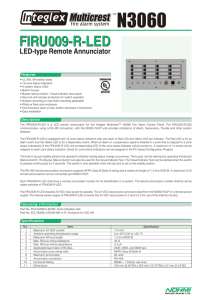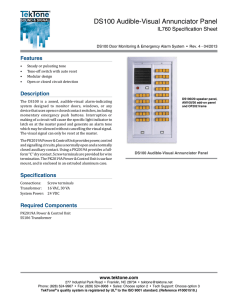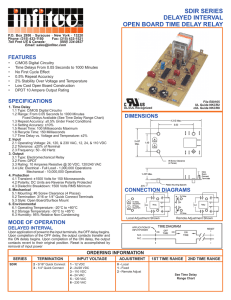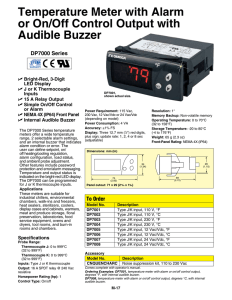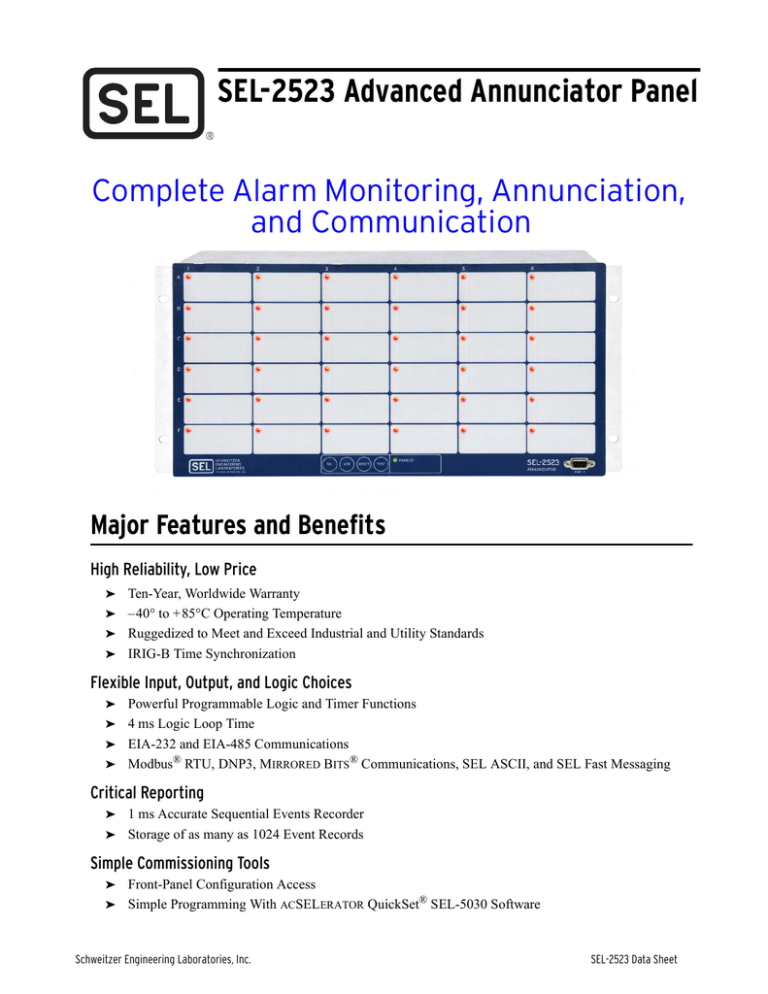
SEL-2523 Advanced Annunciator Panel
Complete Alarm Monitoring, Annunciation,
and Communication
Major Features and Benefits
High Reliability, Low Price
➤
Ten-Year, Worldwide Warranty
➤ –40° to +85°C Operating Temperature
➤ Ruggedized to Meet and Exceed Industrial and Utility Standards
➤ IRIG-B Time Synchronization
Flexible Input, Output, and Logic Choices
➤
Powerful Programmable Logic and Timer Functions
➤ 4 ms Logic Loop Time
➤ EIA-232 and EIA-485 Communications
➤ Modbus® RTU, DNP3, MIRRORED BITS® Communications, SEL ASCII, and SEL Fast Messaging
Critical Reporting
➤
1 ms Accurate Sequential Events Recorder
➤ Storage of as many as 1024 Event Records
Simple Commissioning Tools
➤
Front-Panel Configuration Access
➤ Simple Programming With ACSELERATOR QuickSet® SEL-5030 Software
Schweitzer Engineering Laboratories, Inc.
SEL-2523 Data Sheet
2
Product Overview
The SEL-2523 Annunciator Panel is an advanced
annunciator panel that allows complete alarming,
notification, reporting, and communication. The
SEL-2523 supports many of the standard ISA-18.1
annunciator sequences. It comes standard with 36 alarm
windows that can be independently programmed to
alarm through contact inputs or communication. The
SEL-2523 is designed to read and acknowledge alarms
locally or remotely.
Field Configurable
Alarm Window Labels
Each Column and Row Are
Labeled for Easy Identification
Super Bright LEDs
Front EIA-232 Port for Easy
Access to Settings and Status
Silence, Acknowledge, Reset,
and Test Pushbuttons
Figure 1
SEL-2523 Front View
Optional Communication Card
With EIA-232 or EIA-485 Port
Internal Hardened
Power Supply
for 24/48 Vdc or
125/250 V
Supply Voltages
Two Standard EIA-232
Ports for Use With
Protocols such as
SEL Fast Messaging,
Modbus, and DNP3
Standard IRIG-B Input to
Time-Synchronize Alarm Inputs to 1 ms
Figure 2
Standard 42 Inputs and
11 Contact Outputs
SEL-2523 Rear View
SEL-2523 Data Sheet
Schweitzer Engineering Laboratories, Inc.
3
SEL-2523 Base Unit
➤ Thirty-six front panel alarm points with configu-
Standard Features
➤ ISA-18.1 annunciator sequences: A, M, R, R-1,
F1A, F2M-1, F3A
➤ Forty-two digital inputs and eleven digital contact
outputs
➤ One front and two rear EIA-232 serial ports
➤ Internal power supply 24/48 Vdc or 125/250 Vdc
or Vac
rable windows and indicating LED labels
➤ Modbus RTU, MIRRORED BITS, SEL ASCII and
Compressed ASCII, SEL Fast Meter, Fast Operate,
Fast SER, SEL Fast Message, and Ymodem file
transfer protocols
➤ SEL-4391 Data Courier® Compatibility
Optional Features
➤ IRIG-B input with 1 ms SER time-stamping
➤ ACSELERATOR QuickSet PC software
➤ EIA-232 or EIA-485 Serial Communications Card
➤ DNP3 Level 2 Outstation
Functional Overview
Phone
Communications
Processor
Email/SMS Notification
SCADA
Communications
Critical Alarm Horn
IRIG-B
Time Synchronization
Noncritical Alarm Horn
Field
Device
#1
Figure 3
Field
Device
#2
Field
Device
#3
Field
Device
#36
SEL-2523 Functional Diagram
The SEL-2523 Annunciator Panel is designed to receive
station equipment status information through hard-wired
contacts or communications devices to provide a singlepoint alarm station (see Figure 3). The SEL-2523
monitors equipment, reports on the status of any
equipment that has failed, and notifies local and remote
personnel of current conditions. The SEL-2523 provides
a safe checkpoint for personnel on-site and a common
location where local and remote users can monitor the
status of an alarm.
nonvolatile memory. If power is lost at any point, the
SEL-2523 will return to the last recorded state upon
power up, allowing alarms recorded during power
outages to be maintained for post-event analysis.
When an alarm condition occurs, the SEL-2523
communicates information to the control center, where
the appropriate personnel can be deployed for repair. The
SEL-2523 stores the current state of each alarm point in
Field-configurable labels allow the alarm panel to be
customized and modified as needed. A wide range of
power supply and contact input voltages allow the
SEL-2523 to be installed in virtually any system.
Schweitzer Engineering Laboratories, Inc.
The SEL-2523 indicates the status of up to 36 alarm
points and can be programmed to indicate as few or as
many points as needed for each application. Multiple
alarm panels can be used for high-density alarm
applications.
SEL-2523 Data Sheet
4
Automation
The SEL-2523 Annunciator Panel makes it easy to automate a system-wide alarming station. The SEL-2523
comes standard with remote bits, timers, latches, and
SELOGIC® variables. Use the logic to replace traditional
panel alarms and latching relays, and to eliminate redundant wiring.
Eliminate RTU-to-relay wiring with 40 remote control
bits. Set, clear, or pulse remote control bits via serial port
commands. Program the remote bits into your control
scheme with SELOGIC control equations. Use remote bits
for SCADA-type control operations, e.g., alarm trigger,
acknowledgement, and device status indication. Replace
traditional latching relays for such functions as “remote
control enable,” “auto acknowledge,” or “silence” with
32 latching control bits. Program latch set and latch reset
conditions with SELOGIC control equations. Set or reset
the latch bits via optoisolated inputs, remote bits, or any
programmable logic condition. The latch bits retain their
state when the device loses power.
Output 11 is a Form C contact that can be used either as a
standard output contact or as an alarm status (default).
The alarm status will close the contact any time the
SEL-2523 encounters hardware or software issues such
as Flash failure, power supply failure, RAM failure, or
EEPROM failure.
Control Inputs and Outputs
Fast SER Protocol
The SEL-2523 Annunciator Panel comes standard with
42 independent control inputs and 11 Form A outputs.
The control inputs can be ordered to any of the standard
control input voltages found on station battery systems.
Each input has programmable debounce settings to help
ride through false operations of connected equipment.
Each input has an ac setting that allows you to connect
the input to an ac voltage source. This setting allows the
SEL-2523 to recognize a proper on/off state when a sinusoidal waveform is applied.
The outputs are all 6 A continuous-carry contacts. The
contact can be used to trigger-on critical or noncritical
alarms sent to an internal horn. The contact can be used
to connect a strobe light or large display LED to triggeroff any of the 36 alarm points. This provides maintenance crews with a highly visible alert should a problem
arise.
SEL Fast Sequential Events Recorder (SER) Protocol
provides SER events to an automated data collection system. SEL Fast SER Protocol is available on any serial
port set as “SEL” protocol. Devices with embedded processing capability use these messages to enable and
accept unsolicited binary SER messages from an
SEL-2523.
SEL relays and communications processors have two
separate data streams that share the same serial port. The
normal serial interface consists of ASCII character commands and reports that are intelligible to users with a terminal or terminal emulation package. The binary data
streams interrupt the ASCII data stream to obtain information, and allow the ASCII data stream to continue.
This mechanism allows a single communications channel for ASCII communications (e.g., transmission of a
long event report) interleaved with short bursts of binary
data to support fast acquisition of metering or SER data.
SEL-2523 Data Sheet
Configurable Labels
Each SEL-2523 Annunciator Panel comes with a set of
configurable labels. Use the labels to uniquely identify
each alarm point LED. Preprinted labels are included
(with factory-default text), as are blank label media and a
Microsoft® Word template on CD-ROM. This allows
you to quickly make professional-looking labels for the
SEL-2523. Blank stock labels are also provided for handwritten customization. These customization features
allow easy implementation without the need for adhesive
labels.
Schweitzer Engineering Laboratories, Inc.
5
Integration
The SEL-2523 Annunciator Panel is equipped with three
independently operated serial ports: one EIA-232 port on
the front and two EIA-232 ports on the rear. An additional EIA-232 or EIA-485 port is available as an ordering option. The SEL-2523 comes standard with
ACSELERATOR QuickSet software to aid in setting the
SEL-2523. The SEL-2523 supports settings from a standard ASCII terminal.
The SEL-2523 is designed to easily establish communications to the following:
➤ Connected computers, modems, and protocol converters
➤ An SEL-3530, SEL-3364, or SEL-2032
➤ SCADA serial ports, and/or RTUs for local or
remote communication
Apply an SEL-3530, SEL-3364, or SEL-2032 as the hub
of a star network with point-to-point fiber or copper
connections between the hub and the SEL-2523 (see
Figure 4). The communications processor supports
external communications links, including the public
switched telephone network for engineering access to
Table 1
dial-out alerts, and private line connections of the
SCADA system. SEL manufactures a variety of standard
cables for connecting relays to a variety of external
devices. Consult your SEL representative for more
information.
The SEL-2523 comes with several standardized
protocols to make communications, operations, and
alarm acknowledgement easy. Table 1 lists the various
protocols that the SEL-2523 supports.
Dial-Up ASCII Link
DNP3 SCADA Link
SEL-3530
ASCII reports with
interleaved binary data
SEL-2523
Figure 4
Example Communications System
Open Communications Protocols
Type
Description
Simple ASCII
Plain language commands for human and simple machine communications; use for settings, self-test status,
SER reporting, and other functions
Extended Fast Meter and
Fast Operate
SEL binary protocol for machine-to-machine communications; quickly updates SEL Communications Processors (SEL-2032, SEL-2030, and SEL-2020), SEL Computing Platforms (SEL-3332 and SEL-3351), RTUs,
and other substation devices with device elements, I/O status, time-tags, control commands, and SER; data are
checksum protected; binary and ASCII protocols operate simultaneously over the same communications lines
so control operator information is not lost while a technician is transferring an event report
DNP3 Level 2 Outstation
Distributed Network Protocol with point remapping; includes access to alarm points, contact I/O, targets, and
SER
Fast SER Protocol
Provides SER events to an automated data collection system
Modbus
Modbus; includes access to alarm points, device status, contact I/O, device targets, and SER
MIRRORED BITS Relay-to-Relay
Communications
The SEL-patented MIRRORED BITS communications
technology provides bidirectional device-to-device digital communications. MIRRORED BITS can operate independently on up to two EIA-232 serial ports on a single
SEL-2523 Annunciator Panel. This bidirectional digital
communication creates eight additional virtual outputs
(transmitted MIRRORED BITS) and eight additional virtual inputs (received MIRRORED BITS) for each serial port
Schweitzer Engineering Laboratories, Inc.
operating in the MIRRORED BITS mode. Use these MIRBITS to quickly transmit and receive information
from devices, external I/O, or Programmable Automation
Controllers already connected to the power system. The
communications channel provides a fast, efficient, and
simple way of alarming the SEL-2523 without extra wiring. Each MIRRORED BITS channel is monitored and
logged for integrity. A communications log tracks the
communications status and channel availability, and the
SEL-2523 will alarm for any channel or device failures.
RORED
SEL-2523 Data Sheet
6
Configuration and Commissioning
The included ACSELERATOR QuickSet software simplifies device configuration in addition to providing the following commissioning and analysis support for the
SEL-2523 Annunciator Panel:
➤ Access settings creation help online
➤ Organize settings with the device database manager
➤ Load and retrieve settings using a simple PC communications link
➤ Analyze SER records to verify alarm operation
(see Figure 8)
➤ Use the PC interface to remotely retrieve reports
and other system data
➤ Monitor alarm operation and status during commissioning tests
➤ Operate and monitor the device remotely from a
virtual front panel (see Figure 7)
Figure 7
View Device Overview Display With
QuickSet Software
ACSELERATOR
Sequential Events Recorder (SER)
for Your Digital I/O
Figure 5 Develop Settings Offline With an Intelligent
Settings Editor That Only Allows Valid Settings
The SER records up to 1024 state changes to the millisecond for as many as 96 digital points, and captures the
time of device power-up and settings changes. The
SEL-2523 Annunciator Panel comes standard with alias
names for each element. Each defined SER point can be
assigned different element names for the asserted and
deasserted state. Assigning familiar names for each element provides the SER record reviewer with a clear, at-aglance view of an event. Figure 8 shows an example of
an SER report.
Control inputs are time-tagged and accurate to the millisecond. All other Device Word bits are time-stamped to
the millisecond and processed every four milliseconds.
Figure 6 Create SELOGIC Control Equations With a
Drag-and-Drop Editor and a Text Editor
Figure 8
SEL-2523 Data Sheet
Example SER Report
Schweitzer Engineering Laboratories, Inc.
7
Time Synchronization
The SEL-2523 Annunciator Panel can be timesynchronized through several different time sources. The
IRIG-B input is the most accurate, and can be wired
either through the separate IRIG-B input (see Figure 9)
or through Port 3 on Pins 4 and 6. The time code input
synchronizes the SEL-2523 control inputs to within
±1 ms and all other SER time-stamped data to ±4 ms of
the time-source input. Figure 12 shows the location of
the IRIG-B ports on Card Slot 1. The SEL-2523 can also
be time-synchronized through DNP3 via any of the rear
serial ports set to “DNP” protocol. Although the system
times can vary, the accuracy will typically be 5 to 10 ms.
If necessary, the SEL-2523 can be manually set to the
correct time.
Guideform Specification
The SEL-2523 Annunciator Panel shall provide monitoring, control, and automation. Self-checking functions
shall be included. Specific requirements are as follows:
➤ Front-Panel Visualization. The annunciator shall
display the status of 36 alarm points. Each alarm
point shall be triggered by contact inputs or communications protocols. Each alarm point shall be
uniquely identifiable using configurable labels.
➤ Alarm Acknowledgement. The annunciator shall
silence, acknowledge, and reset alarms from either
the front-panel pushbuttons, the programmable
control inputs, or through any of the available communications protocols: Modbus, DNP3, MIRRORED BITS, and SEL Fast Operate.
➤ SELOGIC Programming Language. The annunciator shall implement logic and control functions
using tools available in the SELOGIC Programming
Language. Logic shall use Boolean logic functions.
Boolean logic loop execution time shall be ≤ 4 ms.
➤ Automation. The annunciator shall include 40
remote control logic points, 32 latching logic
points, 40 variables, and 40 timers.
➤ Flexible I/O. The annunciator I/O shall be userconfigurable to meet end-user application requirements. Each input shall be settable to a debounce
timer or to recognize ac signals.
➤ IRIG-B Synchronized, Time-Stamped Events.
The annunciator shall store as many as 1024 event
records with IRIG-B-synchronized time stamps.
An internal real-time clock shall be used for timestamping if an IRIG-B signal is not available.
➤ Sequential Events Recorder. The annunciator
shall provide a chronological report to determine
the order and cause of events and to assist in troubleshooting. The last 1024 input, output, and element events shall be recorded with 1ms accuracy.
The alarm inputs shall have an accuracy of ±1ms.
The user shall be able to relabel the element name
and on/off status for display in the report.
➤ Digital Device-to-Device Communications. The
annunciator shall have eight transmit and eight
receive logic elements in each of two communications ports for dedicated device-to-device communications. These elements shall be available for use
in control logic.
Schweitzer Engineering Laboratories, Inc.
➤ DNP3. The annunciator shall operate with DNP3
➤
➤
➤
➤
➤
➤
➤
➤
Level 2 Outstation through the standard EIA-232
serial ports. The device shall allow configuration
of any incoming data or data calculated within the
device through the custom DNP3 data map. All
control points within the annunciator shall be
available as DNP3 control points using latch
on/latch off or pulse on/pulse off control functions.
SER data shall be available as time-stamped DNP3
event data. The annunciator shall be capable of up
to three sessions of DNP3 on the available serial
ports.
Modbus. The annunciator shall operate as a Modbus® RTU Slave through a serial connection. The
Modbus RTU Slave implementation shall allow
direct access to any register within the device. The
Modbus implementation shall allow control of any
control point within the I/O processor and controller. The annunciator shall be capable of up to three
sessions of Modbus on the available serial ports.
PC Software. The annunciator shall be compatible
with PC software programs for use in programming control settings, logic functions and retrieving SER data. PC software is not required to use
the SEL-2523. The PC software shall provide a
remote interface of the annunciator for front-panel
state viewing and remote alarm acknowledgement.
Performance Operating Temperature. The
annunciator shall have an operating temperature
range of –40° to +85°C (–40° to +185°F) and a
power supply input operating voltage range of
85–264 Vac, 85–275 Vdc, or 19.2–62.8 Vdc. The
power supply shall be internal to the product.
Specification Compliance. The annunciator shall
be type tested to meet C37.90, IEC 60255,
IEC 60068, and IEC 61000 standards.
Reliability. The vendor shall supply the actual
measured Mean Time Between Failures (MTBF)
for the annunciator upon request.
Service. The annunciator shall include no-charge
technical support for the life of the product.
Manufacturer. The annunciator shall be manufactured in the U.S.A.
Conformal Coating. The annunciator shall have
optional conformal coating to protect the circuit
boards from harsh environments.
SEL-2523 Data Sheet
8
➤ Warranty. The annunciator shall include a ten-
➤ Warranty Return. The vendor shall support a
72-hour turnaround on all warranty repairs.
year, no-questions-asked warranty for all materials
and workmanship. In addition, the warranty shall
cover accidental customer-induced damage.
Front- and Rear-Panel Diagrams
ENABLED
SIL
ACK
RESET
TEST
SEL–2523
ANNUNCIATOR
PORT F
i4197a
Figure 9
SEL-2523 Rack Mount
ENABLED
SIL
ACK
RESET
TEST
SEL–2523
ANNUNCIATOR
PORT F
i4198a
Figure 10
SEL-2523 Panel Mount
SEL-2523 Data Sheet
Schweitzer Engineering Laboratories, Inc.
9
Figure 11
SEL-2523 Rear Panel
Dimensions
Figure 12
SEL-2523 Rack-Mount and Panel-Mount Chassis
Schweitzer Engineering Laboratories, Inc.
SEL-2523 Data Sheet
10
Specifications
Compliance
Time-Code Input
Format:
Demodulated IRIG-B
UL 508
On (1) State:
Vih ≥ 2.2 V
cUL:
CAN/CSA C22.2 No. 14
Off (0) State:
Vil ≤ 0.8 V
CE:
CE Mark: Low Voltage Directive, EMC
Directive
Input Impedance:
2 kΩ
Accuracy:
± 1ms
ISO 9001:2008 Certified
UL:
FCC:
CFR 47 Part 15, Class A
Note: This equipment has been tested and found to comply with the limits for
a Class A digital device, pursuant to Part 15 of the FCC rules. These limits are
designed to provide reasonable protection against harmful interference when
the equipment is operated in a commercial environment. This equipment
generates, uses, and can radiate radio frequency energy and, if not installed
and used in accordance with the instruction manual, may cause harmful
interference to radio communications. Operation of this equipment in a
residential area may be likely to cause harmful interference in which case the
user will be required to correct the interference at his own expense. Any
changes or modifications not expressly approved by the manufacturer can
void the user’s authority to operate the equipment.
General
Outputs
General
OUT11 is Form C Trip Output, all other outputs are Form A.
Dielectric Test Voltage:
2000 Vac
Impulse Withstand
Voltage (Uimp):
4000 V
Mechanical Durability:
10,000 no-load operations
DC Output Ratings
Electromechanical
Temperature Range
–40° to +85°C (–40° to +185°F), per IEC 60068-2-1 and 60068-2-2
Note: Not applicable to UL applications.
Operating Environment
Pollution Degree:
2
250 Vdc
Rated Voltage Range:
19.2 to 275 Vdc
Rated Insulation Voltage:
300 Vdc
Make:
30 A @ 250 Vdc per IEEE C37.90
Note: Make rating per IEEE C37.90:1989.
Overvoltage Category:
II
Relative Humidity:
5–95%, noncondensing
Maximum Altitude:
Rated Operational
Voltage:
2000 m
Continuous Carry:
6 A @ 70°C; 4 A @ 85° C
Thermal:
50 A for 1 s
Contact Protection:
360 Vdc, 40 J MOV protection across
open contacts
Weight
4.2 kg (10 lb)
Operating Time (coil
energization to contact
closure, resistive load): Pickup or dropout time ≤ 8 ms typical
Printable Window Size
30.5 mm x 61 mm (1.20" x 2.40")
Breaking Capacity (10,000 operations) per IEC 60255-0-20:1974:
Inputs
24 V
48 V
125 V
250 V
Optoisolated Control Inputs
When Used With DC Control Signals
250 V
220 V
125 V
110 V
48 V
24 V
ON for 200–275 Vdc
ON for 176–242 Vdc
ON for 100–137.5 Vdc
ON for 88–121 Vdc
ON for 38.4–52.8 Vdc
ON for 15–30 Vdc
OFF below 150 Vdc
OFF below 132 Vdc
OFF below 75 Vdc
OFF below 66 Vdc
OFF below 28.8 Vdc
OFF for < 5 Vdc
When Used With AC Control Signals
250 V
220 V
125 V
110 V
48 V
24 V
ON for 170.6–300 Vac
ON for 150.3–264 Vac
ON for 85–150 Vac
ON for 75.1–132 Vac
ON for 32.8–57.6 Vac
ON for 14–27 Vac
Current Draw at
Nominal DC Voltage:
Rated Insulation Voltage:
Rated Impulse Withstand
Voltage (Uimp):
SEL-2523 Data Sheet
0.75 A
0.50 A
0.30 A
0.20 A
L/R=40 ms
L/R=40 ms
L/R=40 ms
L/R=40 ms
Cyclic Capacity (2.5 cycles/second) per IEC 60255-0-20:1974:
24 V
48 V
125 V
250 V
0.75 A
0.50 A
0.30 A
0.20 A
L/R=40 ms
L/R=40 ms
L/R=40 ms
L/R=40 ms
Note: Per IEC 60255-23:1994, using the simplified method of assessment.
AC Output Ratings
OFF below 106 Vac
OFF below 93.2 Vac
OFF below 53 Vac
OFF below 46.6 Vac
OFF below 20.3 Vac
OFF below 5 Vac
Electromechanical
Maximum Operational
Voltage (Ue) Rating:
240 Vdc
Insulation Voltage (Ui)
Rating (excluding
EN 61010-1):
300 Vac
300 Vac
Voltage Protection Across
Open Contacts:
270 Vac, 40 J
4000 V
Rated Operational
Current (Ie):
3 A @ 120 Vac; 1.5 A @ 240 Vac
2 to 4 mA (except for 24 V, 8 mA)
Schweitzer Engineering Laboratories, Inc.
11
Conventional Enclosed
Interruptions
Thermal Current (Ithe)
Rating:
5A
Rated Frequency:
50/60 ± 5 Hz
Pickup/Dropout Time:
≤ 8 ms (coil energization to contact
closure)
Electrical Durability Make
VA Rating:
3600 VA, cosφ = 0.3
Electrical Durability
Break VA Rating:
360 VA, cosφ = 0.3
Low-Voltage Model:
10 ms @ 24 Vdc
50 ms @ 48 Vdc
High-Voltage Model:
50 ms @ 125 Vac/Vdc
100 ms @ 250 Vac/Vdc
Sampling and Processing Specifications
Digital Inputs
Sampling Rate:
Communications
Ports
Standard EIA-232 (3 ports)
Location (fixed):
1 front panel
2 rear panel
Data Speed:
300–38400 bps
Refresh Rate:
2 kHz
Logic Update:
Every 4 ms
Control Processing:
Every 4 ms
Type Tests
Environmental Tests
Enclosure Protection:
Optional Communications Card
300–38400 bps
Protocols
Modbus RTU slave
Vibration Resistance:
IEC 60255-21-1:1988, Class 1
IEC 60255-21-3:1993, Class 2
Shock Resistance:
IEC 60255-21-2:1988, Class 1
Cold:
IEC 60068-2-1:2007
16 hr at –40°C
Damp Heat, Cyclic:
IEC 60068-2-30:2005
25° to 55° C,
6 cycles, 95% relative humidity
Dry Heat:
IEC 60068-2-2:2007
16 hr at +85° C
DNP3 Level 2 Outstation (Serial)
SEL MIRRORED BITS (MBA, MBB, MB8A, MB8B)
Ymodem file transfer on the front and rear ports
Xmodem file transfer on the front port
IEC 60529:2001
IP40 front panel and IP20 for rear
terminals
Standard EIA-232 or EIA-485 (ordering option)
Data Speed:
2 kHz
Contact Outputs
SEL ASCII and Compressed ASCII
Dielectric Strength and Impulse Tests
SEL Fast Meter
SEL Fast Operate
Dielectric (HiPot):
IEC 60255-5:2000
IEEE C37.90-2005
2.5 kVac on contact I/O
3.1 kVdc on power supply
Impulse:
IEC 60255-5:2000
0.5 J, 5 kV on power supply,
contact I/O
SEL Fast SER
SEL Fast Message unsolicited write
SEL Fast Message read request
SEL Event Messenger Points
Maximum Concurrent Connections
RFI and Interference Tests
DNP3 Level 2 Outstation:
3
EMC Immunity
Modbus RTU Slave:
3
Electrostatic Discharge
Immunity:
IEC 61000-4-2:2001
Severity Level 4
8 kV contact discharge
15 kV air discharge
IEEE C37.90.3-2001
8 kV contact discharge
15 kV air discharge
Power Supply
Rated Supply Voltage
Low-Voltage Model:
24/48 Vdc
High-Voltage Model:
110/250 Vdc
110/240 Vac, 50/60 Hz
Radiated RF Immunity:
IEC 61000-4-3:2006, 10 V/m
IEEE C37.90.2-2004, 35 V/m
Low-Voltage Model:
19.2–62.8 Vdc
Fast Transient,
Burst Immunity:
High-Voltage Model:
85–275 Vdc
85–264 Vac
IEC 61000-4-4:2004 + CRGD
IEC 60255-22-4:2002
4 kV @ 5.0 kHz
2 kV @ 5.0 kHz for comms ports
Input Voltage Range
Power Consumption
AC:
<40 VA
DC:
<15 W
Schweitzer Engineering Laboratories, Inc.
Surge Withstand Capability: IEC 60255-22-1:2005
2.5 kV common-mode
1 kV differential-mode
1 kV common-mode on comms ports
IEEE C37.90.1-2002
2.5 kV oscillatory
4 kV fast transient
SEL-2523 Data Sheet
12
Conducted RF Immunity:
IEC 61000-4-6:2006, 10 Vrms
Magnetic Field Immunity:
IEC 61000-4-8:2001
1000 A/m for 3 seconds
100 A/m for 1 minute
EMC Emissions
Conducted Emissions:
IEC 60255-25:2000
Radiated Emissions:
IEC 60255-25:2000
Power Interruption Tests
Interruptions:
IEC 61000-4-11:2004 Voltage Dips
Operating Sequences
All per ISA-18.1-1979 (R1992)
Sequence M—Manual Reset
Sequence R—Ringback
Sequence R-1—Ringback With Options
Sequence A—Automatic Reset
Sequence F1A—Automatic Reset First Out With no Subsequent
Alarm State
Sequence F2M-1—Manual Reset First Out With no Alarm Flashing
and Silence Pushbutton
Sequence F3A—Automatic Reset First Out With First Out Flashing
and Reset Pushbutton
© 2008–2015 by Schweitzer Engineering Laboratories, Inc. All rights reserved.
All brand or product names appearing in this document are the trademark or registered trademark of their respective holders. No SEL trademarks may be used without written permission.
SEL products appearing in this document may be covered by U.S. and Foreign patents.
Schweitzer Engineering Laboratories, Inc. reserves all rights and benefits afforded under federal and international copyright and patent laws in its products, including without limitation
software, firmware, and documentation.
SCHWEITZER ENGINEERING LABORATORIES
2350 NE Hopkins Court • Pullman, WA 99163-5603 USA
Phone: +1.509.332.1890 • Fax: +1.509.332.7990
Internet: www.selinc.com • E-mail: info@selinc.com
The information in this document is provided for informational use only and is subject to
change without notice. Schweitzer Engineering Laboratories, Inc. has approved only the
English language document.
This product is covered by the standard SEL 10-year warranty. For warranty details, visit
www.selinc.com or contact your customer service representative.
SEL-2523 Data Sheet
*PDS2523-01*
Date Code 20150630

